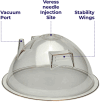Post-Market Clinical Follow-Up Study of the LevaLap 1.0 during Laparoscopic Access
- PMID: 40342608
- PMCID: PMC12061069
- DOI: 10.4293/JSLS.2025.00014
Post-Market Clinical Follow-Up Study of the LevaLap 1.0 during Laparoscopic Access
Abstract
Background and objectives: The LevaLap 1.0 (Core Access Surgical Technologies, Atlanta, GA) was designed to promote safer, more stable, and more predictable abdominal access when using the Veress needle for insufflation. We report on the first postmarket clinical study (PMCF) assessing experience with the use of the LevaLap 1.0 during gynecologic laparoscopic surgery.
Methods: Prospective multicenter study, including women ≥18 years old, excluding pregnancy, access site surgery in prior 10 days, abdominal hernia, contraindication to Veress needle or laparoscopy use, body mass index (BMI) >30 kg/m2, and inability/unwillingness to provide consent.
Results: A total of 158 subjects were included, involving nine surgeons. Mean age was 43.6 ± 14.6 years and mean BMI: 24.7 ± 3.8 kg/m2. Access site was 83.5% transumbilical, 15.2% periumbilical, and 1.2% other. Using the device 96.8% (95% confidence interval [CI]: 92.8-99.0%, n = 152/157) of patients' access was successfully achieved at first attempt and 99.4% (95% CI: 96.5-100.0, n = 156/157) within the first 2 attempts. One minor device-related adverse event was reported: a circular redness on the skin at the site of device application, resolving spontaneously. Surgeons noted easier access in 59.5%, increased confidence in 68.3%, increased access control in 67.1%, and increased access efficiency in 66.4% of cases.
Conclusion: This PMCF study indicates that the use of the LevaLap 1.0 resulted in easier, greater control and greater efficiency during abdominal access using the Veress needle. In 96.8% access was achieved at first attempt and in 99.4% within the first 2 attempts. The use of the LevaLap 1.0 may facilitate abdominal access when using the Veress needle for insufflation.
Keywords: Abdominal access; Laparoscopy; Postmarket clinical follow-up; Surgical complications; Veress needle.
© 2025 by SLS, Society of Laparoscopic & Robotic Surgeons.
Figures



Similar articles
-
Laparoscopic entry techniques.Cochrane Database Syst Rev. 2012 Feb 15;(2):CD006583. doi: 10.1002/14651858.CD006583.pub3. Cochrane Database Syst Rev. 2012. Update in: Cochrane Database Syst Rev. 2015 Aug 31;8:CD006583. doi: 10.1002/14651858.CD006583.pub4. PMID: 22336819 Updated.
-
Heated insufflation with or without humidification for laparoscopic abdominal surgery.Cochrane Database Syst Rev. 2016 Oct 19;10(10):CD007821. doi: 10.1002/14651858.CD007821.pub3. Cochrane Database Syst Rev. 2016. PMID: 27760282 Free PMC article.
-
Laparoscopic entry techniques.Cochrane Database Syst Rev. 2008 Apr 16;(2):CD006583. doi: 10.1002/14651858.CD006583.pub2. Cochrane Database Syst Rev. 2008. Update in: Cochrane Database Syst Rev. 2012 Feb 15;(2):CD006583. doi: 10.1002/14651858.CD006583.pub3. PMID: 18425957 Updated.
-
Videolaryngoscopy versus direct laryngoscopy for adult patients requiring tracheal intubation.Cochrane Database Syst Rev. 2016 Nov 15;11(11):CD011136. doi: 10.1002/14651858.CD011136.pub2. Cochrane Database Syst Rev. 2016. Update in: Cochrane Database Syst Rev. 2022 Apr 4;4:CD011136. doi: 10.1002/14651858.CD011136.pub3. PMID: 27844477 Free PMC article. Updated.
-
Risk of thromboembolism in patients with COVID-19 who are using hormonal contraception.Cochrane Database Syst Rev. 2023 Jan 9;1(1):CD014908. doi: 10.1002/14651858.CD014908.pub2. Cochrane Database Syst Rev. 2023. Update in: Cochrane Database Syst Rev. 2023 May 15;5:CD014908. doi: 10.1002/14651858.CD014908.pub3. PMID: 36622724 Free PMC article. Updated.
References
-
- Market and Markets™. Laparoscopic instruments market by product (laparoscope, insufflator, suction/irrigation systems, access & energy devices), application (gynecology, general, urology, colorectal, bariatric, pediatric), end user (hospital, ASC) & region – global forecast to 2026. Northbrook, IL: Market and Markets™; 2021. Available at: https://www.marketsandmarkets.com/Market-Reports/laparoscopic-instrument.... Accessed July 21, 2024.
-
- iData Research. Over 13 million laparoscopic procedures are performed globally every year. Burnaby, Canada: iData Research; 2020. Available at: https://idataresearch.com/over-13-million-laparoscopic-procedures-are-pe.... Accessed July 20, 2024.
-
- Magrina JF. Complications of laparoscopic surgery. Clin Obstet Gynecol. 2002;45(2):469–480. - PubMed
-
- Pryor A, Mann WJ, Jr, Bates AT. Complications of laparoscopic surgery. In: UpToDate, Marks J, Falcone T. (Section Eds). Waltham, MA: UpToDate. Accessed July 20, 2024.
-
- Fuller J, Ashar BS, Carey-Corrado J. Trocar-associated injuries and fatalities: an analysis of 1399 reports to the FDA. J Minim Invasive Gynecol. 2005;12(4):302–307. - PubMed
Publication types
MeSH terms
LinkOut - more resources
Full Text Sources
